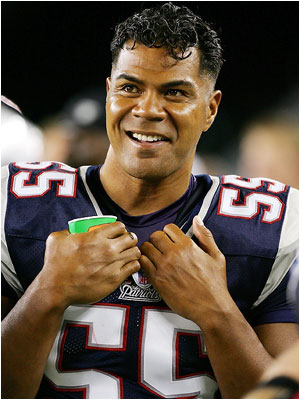Columnists: Please use more care when writing about the bounty scandal

SI quotes former linebacker Junior Seau (pictured above) as saying "When you say bounty and you talk about intentionally taking someone out, in essence you're talking about affecting his livelihood. That's not football."
There are so many conversations springing from the New Orleans Saints’ bounty scandal that the waters got muddied too quickly. In the rush to make the point that “bounties are no big deal” or “all bounties or extra payments are terrible and unacceptable” people are forgetting to make some key distinctions. One is the distinction between trying hard to make a big hit or play and intentionally trying to injure someone, the second is a distinction between rewarding a player for making a tough play vs rewarding a player for injuring an opponent.
Those things are absolutely and unequivocally not the same, and I don’t understand why many writers don’t see it or haven’t made a better effort to point it out to the public. Guys get injured on fairly minor plays (think Eagles Jason Babin smushing Cowboys Tony Romo’s hand against his helmet) and bounce back up from hard hits and play the next snap (think Darren Sharper destroying Kevin Faulk who bounces up after the play like a Bop Bag). A hard hit is not necessarily an attempt to injure nor is an injury guaranteed. That’s why tying rewards to injuries goes beyond asking guys to make a play, and crosses the line over to encouraging them to do something beyond that like twisting an ankle at the bottom of a pile or hitting late or low.
Ethically, paying players extra for a hard hit violates nothing in the game except the collective bargaining agreement as incentives should be included in contracts and counted against the salary cap. But paying players under the table for hurting another person is the part that is wrong, and no amount of excuses is going to make that feel right when it’s considered thoughtfully.
I also think some are grossly out of touch with players especially the modern player. Today’s players are even more concerned about their fellow man than guys in the past. Nowadays, guys consider themselves to be a part of a very elite fraternity. Many played together in college, some party together, they tweet each other, express a desire to play together, narrate each other’s profiles, and so on. Even fierce rivals like Terrell Suggs and Hines Ward will appear on TV together. The vast majority of players are NOT out to injure each other though they may be ready and excited about inflicting a little pain in the name of good football. And, of course, occasionally there may be a moment of anger where they DO try to injure whoever has pissed them off but that does not reflect most players’ general approach to their jobs. Besides, many times those angry plays tend to stand out (think: N’damukong Suh on Thanksgiving Day).
[To finish reading this article please click on the "Read More" tab below]
As Jim Trotter wrote in his Sports Illustrated piece in which he interviewed some heavy hitters like retired linebacker Junior Seau, many players cope with guilt when they seriously injure someone:
Ken Norton Jr. couldn’t have been more pumped for the 1994 season opener. He was preparing to make his 49ers debut after winning back-to-back Super Bowls with the Cowboys. The game was being played before a national TV audience for Monday Night Football.
Nearly 18 years later Norton, who played middle linebacker with an infectious smile and a physical style, remembers the game as if he were watching it on a flat screen in his Seattle-area home. Not because the night concluded with a 44-14 demolition of the Raiders but because it ended the career of running back Napoleon McCallum.
The former two-time All-America at Navy took a third-quarter handoff and plowed into the line, where Norton and defensive tackle Bryant Young were waiting. When they brought McCallum to the grass, his left knee hyperextended so severely that doctors later feared his lower leg might have to be amputated.
Norton, who was trapped beneath McCallum for several minutes, was so shaken by the injury that he thought about retiring. His voice was somber on Sunday evening as he reflected on the incident. “You spend a lot of time with the guys, and you can’t help but care about them—you know what they’ve been through, because you’ve gone through it yourself,” said Norton, who retired after the 2000 season and is now the linebackers coach for the Seahawks. “If someone is hurt and you were involved with it, you certainly contemplate why you should still be out there.”
I understand that the line between hitting to hurt and hitting to injure is blurry on the surface, but in practice it is actually pretty clear. Injuries caused by player to player contact should be (and for most players IS) an unintended consequence of tough play not a desired result. On some level, I feel like thinking of players as heartless savages is one way some people reconcile what they see on the field. But the reality is much messier than that. And somehow reality has gotten lost in the rush to judge this situation one way or the other.






